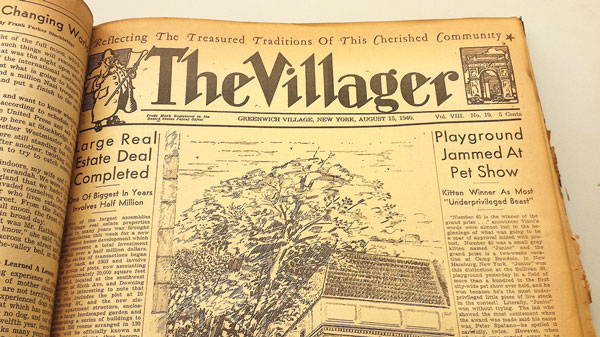BY STEVEN WISHNIA | There are more coffeehouses with live music and poetry in Tryon, North Carolina, population 1,200, than there are in all of Greenwich Village, Chelsea and Hell’s Kitchen. The Trade St. Gallery and Coffeehouse, where eight years ago I was guest bassist for an Appalachian swing band called Cantankerous, still exists.
Think about that for a minute. The Village and San Francisco’s North Beach were the places where the Beats adapted the Italian social institution of espresso coffeehouses into a venue for live poetry, for spieling skeins of spontaneous bop prosody. There are none left, at least as far as I know. Gizzi’s on W. Eighth St., which closed around three years ago, is the last one I remember.
Who would have ever thought that Staten Island would have more coffeehouses with poetry readings than Greenwich Village? I’m referring to the rather hippiefied ETG bookstore/cafe in Tompkinsville, down the block from where Eric Garner was killed. The coffeehouse as a place for live performance or simply to hang out for a few hours is no longer economically sustainable in most of Manhattan.
“You can only charge so much for a cup of coffee,” a co-owner of the Big Cup — whose yellow walls with daisy-age painted flowers provided a haven for gay men and others in Chelsea — said when it closed in 2005. Its rent had more than tripled in the 11 years it was open. The model that is sustainable once commercial rents rise that high is a place where you sit for 25 minutes and leave, where people are far more likely to be on Facebook than having a conversation with an in-the-flesh human.
“Neighborhoods change, and these coffeehouses are being replaced by others,” goes the answer. “You just have to go to Brooklyn.” But they’re not being replaced. Yes, there are places like Espresso 77 in Jackson Heights (which occasionally features live rembetica music, the Greek counterpart of 1930s viper blues), but coffeehouses that are social and artistic centers are inevitably short-lived. They have been reduced to transitional businesses for gentrification. They appear soon after the first artist types arrive in Flatbush or Bushwick, and get pushed out when the real money comes in. If they are replaced, it’s usually by a Starbucks. The Flying Saucer, a UFO-themed coffeehouse on Atlantic Avenue in Brooklyn, where I wrote several bits of my second novel, disappeared around the time its block became dominated by the kind of boutiques that have one rack of severely expensive dresses.
The existence of coffeehouses as venues and hangouts is one aspect of how cheap rent is essential to the social ecology of both the arts and the city as a whole. To have a viable scene in any of the arts — music, theater, writing, painting, whatever — artists need to be able to survive and do their work; to have places to perform; to be able to find an audience; and ultimately, to have a community.
Cheap rent is essential for all of these. First, unless you’re already commercially successful, being an artist requires working a second job — writing, rehearsing, drawing, plus hustling to get gigs or published — on top of your day job. If the amount of work you have to do just to make your rent leaves you drained, you can’t create.
Second, venues that don’t have Damoclean overhead can afford to put on more varied genres and lesser-known performers — or merely survive. The math is simple: A venue paying $15,000 a month rent has to bring in 50 people spending $10 every single night before any other expenses. (If 50 people doesn’t sound like much, there are hundreds of talented musicians in the city who are lucky to draw 10.) Anyone who has followed the music scene here over the last decade can list the losses: CBGB, Tonic, the Lakeside Lounge, Southpaw in Park Slope, and a slew of do-it-yourself spaces in Williamsburg, including 285 Kent, Death by Audio, and the Brooklyn Rod and Gun Club.
The presence of big names obscures the destruction of the roots, the places where younger people develop their craft and older ones who haven’t “made it” keep at it. Yes, you might have to wade through a lot of mediocrity and amateurishness to find the gems, but this is the soil that nurtures them and encourages them to keep going.
Third, venues need audiences who have time and money to see them, who aren’t too broke or overworked to come out, or spun out to the far reaches of the city, where getting home means an hour on the late-night subway. While it’s healthy that live music, poetry, theater and art have blossomed outside Manhattan, one reason Greenwich Village, the East Village and the Lower East Side were once such fertile creative communities was that so much was within walking distance — people didn’t have to commute, and could run into each other repeatedly and spontaneously.
This could be summed up as the need for a community — of audience, collaborators and colleagues. It’s much more crucial in the collective arts, like music and theater, but it also benefits the more solitary creative types, like writers and cartoonists. Lower Manhattan was so fertile for much of the 20th century because it contained multiple, overlapping genres and subcultures — punk rock and free jazz, Nuyorican poetry and Off Off Broadway theater. Replacing that kind of community is made much more difficult by landlords using young artists as pawns for gentrification, with the yuppie bishops and castles inexorably following as they advance stop by stop along the L train. That process also segregates neighborhoods by age.
The need for cheap rent and community is about much more than the arts. The New York of the ’70s was crime-ridden and decaying, but it was a place where if you were working, you could afford an apartment; if you had a middle-class income, you could afford a nice one. No more. The economy is broken for many of us. Having skills no longer means being able to find a decent-paying job. Working no longer means making enough to pay rent. The solution to this isn’t job training, “giving people the tools they need to compete.” No matter how educated people are, many will still be deli-counter workers, cabdrivers, clothing-store clerks, home healthcare aides and janitors. They need places to live, too.
Do we want to be a city where people can raise children, where the young can live independently and get to know the people who were there before them, where the old can live around people who’ve known them for decades? Or do we want to be an American version of Dubai, a place where all the good spots are occupied by millionaires, and servant-class workers are crammed into rooms on the outskirts?
What can be done? For residents, a good start would be stronger rent controls and the construction of massive amounts of genuinely affordable new housing. That means rents low enough for the half of New York households that make less than $50,000 a year, the one-third who live on less than $600 a week, instead of the current formula, which subsidizes $3,000-a-month apartments as “below market.” For businesses, some form of commercial rent control would help. None of this is likely to be politically possible without quasi-revolutionary change, one that creates a society that respects working people and their leisure instead of worshipping the tsunami of money that “creatively” destroys everything in its way.


















